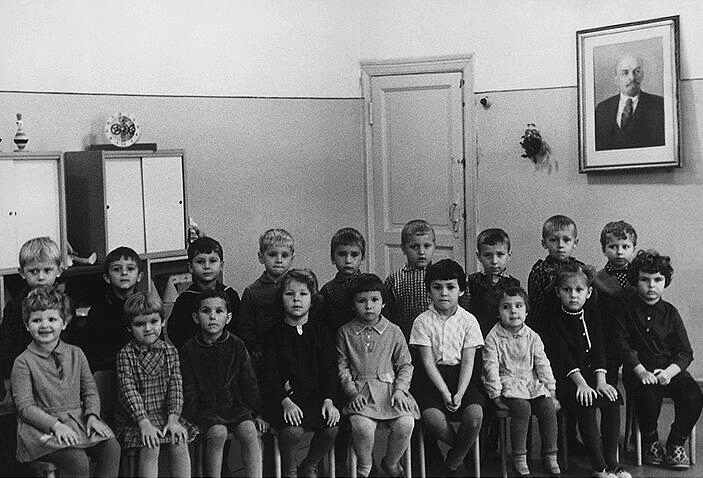
Cold War Era: Soviet Life Style

Figure 1.--The Soviet Union put a considerable emphasis on education. Academic standards were high. In many areas, esoecially in math ans scince, higher than in American schools. Soviet schools, however, did not encorage the children to ask questions or question authority. Children that did so encountered problems and might be denied access to higher education. As a result, when the Soviet economy began to stagnate in the 1970s neither the public or the leadership were willing to questioned the basic pribiples of public ownwrship and planned economy. Russian companies even today are generally unable to compete in the intenational market.
|
|
An interesting topic is what life was like in the Soviet Union during the Cold War. This includes approximately four decadeds, more than half of the span of the Soviet Union. The first decade included the beginning of the Cold War and the rule by Stalin. Stalin died (1953) and was repudiated by the 20th Party Congress (1956). This ended Stalinism, but what followed was periods of relative liberalism and conservative reaction. Even so there was never a teturn to Stalinist Terror. While this meant change the underlying political reality was that the Soviet system did not trust the people. Governernt was retained in the hand of Party aparatchecks which the public had no role in choosing. Economically there were improvements. The life style of the acerahe citizen improved substantially in the 1950s and 60s. His living circimstances, access to consumer goods and diet improved through the 1960s. After that there was little improvement and Soviet citizens had libing conditions far below that of Western Europe. This was not altogether apparent to Soviet citizens, except for people in the Baltics--especially the Estonians who had the cgreatest access to Western media. Despite the imprivements, living conditions were poor. There were longlines at food stores and the choice and quality of both food and consumer goods was far below that of Western Europe. In sharp contrast to the West, the Soviet consumer had basically no influence. Soviet managers were rewarded for meeting the plan, but for pleasing consumers. Agriculture remained a major weakness with poor yields. Industry was hearalded as a great sucesss, but the inefficenes of Soviet industry did not become generally apparent until the fall of the Soviet Union and manufacturers had to compete with foreign companies. These inefficeines were of course the reason that living standards during the Soviet era were so faer below Western Europe. The comparison with Western Europe is the best insex because both Russia and SWestern Europe has well educated populations. Most urban residents lived in aparment blocks. There were many reports of shody construction and poor maintenance. Most people did not have private cars. Health care was free, but in many ways poor. There wee high levels of alcoholism and life spans were below European levels and unlike the West, not improving. Travel was limited even with the Soviet Union. Some citizens were able to take cacations, usually through work place/factory arrangenments. The Soviers put considerable emphasis on education. Educational standards were high, but had a high political content. Access to higher education was based on a mixture of ability and political reliability.
HBC

Navigate the Boys' Historical Clothing Web Site:
[Return to Main Cold War: Phase II page]
[Return to Main Cold War page]
[Return to Main Communism page]
[Introduction]
[Activities]
[Biographies]
[Chronology]
[Clothing styles]
[Countries]
[Bibliographies]
[Contributions]
[FAQs]
[Glossaries]
[Images]
[Links]
[Registration]
[Tools]
[Boys' Clothing Home]
Created: 9:46 PM 10/7/2009
Last updated: 9:46 PM 10/7/2009



